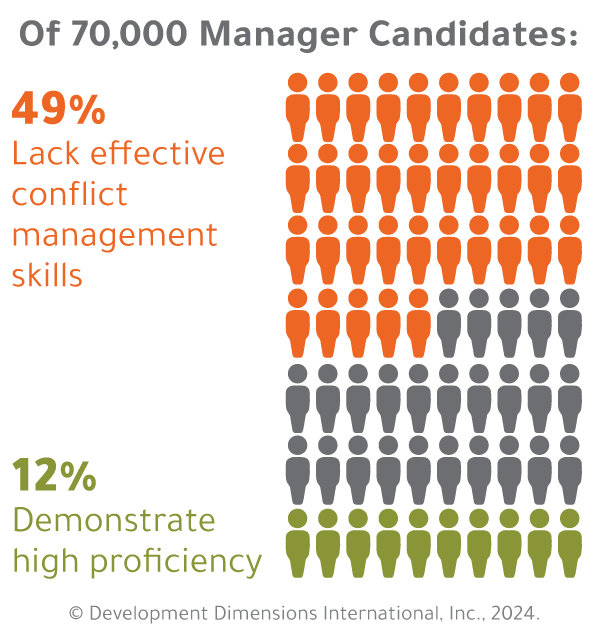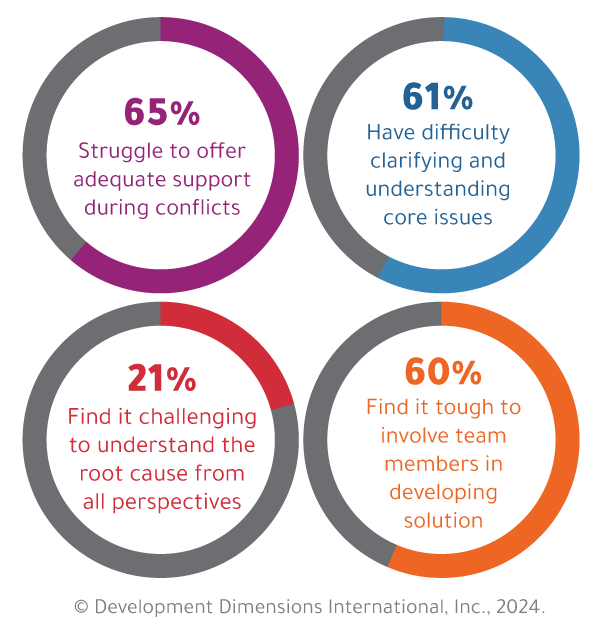Conflict in the workplace is inevitable and sometimes disruptive. The real issue, however, is poor conflict management, which significantly impacts employees.
Alarmingly, leaders are often not prepared to handle these situations. According to DDI's Global Leadership Forecast 2023, only 30% of leaders feel confident managing conflict in the workplace.

Even more troubling, DDI's assessments of more than 70,000 manager candidates reveal that nearly half (49%) lack effective conflict management skills. Moreover, only 12% demonstrate high proficiency in this crucial area. This leaves organizations vulnerable to lower productivity, high turnover, and damaged morale.
But there are clear ways that organizations can better manage conflict to foster innovation, growth, and stronger teams. HR and L&D professionals are vital in developing leaders' conflict management skills. With the right coaching, leaders can transform conflict from a roadblock into an opportunity.
Ahead, we'll explore why conflict arises and its impact on individuals and teams. Plus, how can managing conflict in the workplace be a catalyst for positive change?
According to DDI research, only 30% of leaders feel confident managing conflict in the workplace.
Causes of Workplace Conflict
Conflict in the workplace rarely occurs out of the blue—it typically stems from various underlying factors. These sources of tension may be subtle at first. But if leaders ignore minor issues, they can grow into major disputes, harming team performance and morale. Consider these common sources of tension:
Communication Breakdowns
Unclear or incomplete communication can lead to misunderstandings and frustration.
Value Differences
Clashing personal or professional values can create tension around priorities or ethics.
Resource Competition
Limited resources—whether budgets, staff, or equipment—can spark disputes.
Role Ambiguity
Confusion about responsibilities or expectations can lead to resentment and blame-shifting.
Personality Clashes
Differing working styles or personalities may cause friction.
Organizational Change
Structural, leadership, or procedural changes can unsettle employees, triggering resistance.
Workload Imbalances
Uneven work distribution fosters a sense of unfairness and can breed resentment.
When leaders recognize these triggers, they can address conflicts before they escalate. This not only prevents disputes but fosters a culture where employees navigate challenges constructively.
The Impact of Workplace Conflict
Unresolved workplace conflict affects more than just the people involved—it spreads across teams and organizations. The negative effects include:
Decreased Productivity
Conflict can significantly reduce individual and team output.
Lowered Morale
Ongoing conflicts can decrease job satisfaction and engagement.
Increased Stress
Unresolved tension raises stress levels and potential burnout.
Damaged Relationships
If left unchecked, conflict erodes trust and cooperation among coworkers.
Higher Turnover
Toxic environments push employees to leave, increasing hiring and training costs.
Reduced Creativity
Conflict hinders problem solving and innovation.
Health Issues
Stress from conflict can cause physical and mental health issues, further lowering productivity.
Conversely, when organizations prioritize conflict management, they see stronger teams and higher employee retention. What's more, they position the organization for long-term success.
If left unchecked, conflict erodes trust and cooperation among coworkers.
A Leader's Role in Resolving Conflict
Leaders play a crucial role in workplace conflict resolution. However, their primary responsibility is guiding the resolution, not solving the problem themselves. Effective leaders help teams work through conflicts independently by offering support and guidance. This approach not only resolves immediate issues but also builds trust and self-reliance.

However, many leaders lack the skills required for this facilitator role:
- 65% of leaders struggle to offer adequate support and resources to their team during conflicts.
- 61% of leaders have difficulty clarifying and understanding the conflict's core issues.
- Mid-level leaders struggle to remain impartial, as 21% say understanding the root cause from all perspectives is their biggest challenge.
- 60% of leaders find involving team members in developing solutions challenging.
These statistics highlight a significant gap in leadership skills. To effectively coach team members through conflicts, leaders need to:
- Provide support without taking over.
- Clarify situations to understand conflicts fully.
- Remain open to all sides of an issue.
- Involve team members in developing solutions.
Unfortunately, as the data illustrates, these conflict management skills are not innate for most leaders. Organizations must prioritize leadership development programs that focus on these specific areas. By learning and practicing effective conflict facilitation techniques, leaders can create an environment where employees feel supported. This also makes employees feel empowered to address issues independently.
Quality development is an important first step to helping leaders effectively manage conflict. To help leaders advance their skill set requires a shift in perspective from problem solver to facilitator. Leaders will also need ongoing practice in emotional intelligence, coaching, and fostering open dialogue. With this approach, leaders can transform conflicts into opportunities for team growth and cohesion.
By learning and practicing effective conflict facilitation techniques, leaders can create an environment where employees feel supported.
Stages of Conflict and Warning Signs
Leaders must spot warning signs early and aim to offer support before a conflict spirals out of control. Conflict often unfolds in phases:
- Differences: Differences can fuel innovation and creativity. When people work through differences productively, they lead to the discovery of ideas and improved ways of doing things.
- Discord: When emotions run high or personal interests dominate, tensions can disrupt collaboration.
- Dispute: At this stage, relationships are damaged, and productivity suffers.
It's crucial for leaders to recognize the tipping point between healthy differences and harmful disputes. Early intervention—through open dialogue, mediation, or realigning goals—can prevent conflict from spiraling.
To do this, leaders can ask themselves, "When do these differences start negatively affecting others or the organization?" They should also watch for warning signs such as poor communication, avoidance, and rising stress levels.
Coaching for Effective Conflict Management
Coaching is a valuable tool for helping employees navigate conflict. But before focusing on solutions, leaders should first listen and address the personal concerns of those involved.
While all five Key Principles are valuable during conflict discussions, leaders will find Empathy and Involvement particularly important. These skills help people overcome emotional barriers. This enables them to discover and resolve the true causes of workplace conflict.
Leaders can use empathy to defuse strong emotions and create an environment where employees feel heard. This encourages collaboration on solutions. On the other hand, they can use involvement to clarify a situation or seek ideas and buy-in for solutions. Together, these principles build trust and encourage team members to own the resolution.
Mediation Tactics for Conflict Resolution
When coaching alone doesn't help team members resolve a conflict, leaders may need to mediate. Mediation involves bringing conflicting parties together, facilitating discussion, and guiding them toward workable solutions. Successful mediation tactics include:
Setting ground rules.
These rules should include respecting everyone's feelings and ideas, admitting mistakes, and avoiding blame.
Facilitating ownership of resolution.
Offer your thoughts only as needed. Be sure to ask questions to prompt conversation and build esteem when people contribute ideas.
Staying neutral and objective.
Focus on facts and check for mutual understanding. Ensure all voices are heard.
Ask people to restate another person's perspective to confirm understanding.
Be sure to give all perspectives equal airtime and connect everyone to a common goal.
Mediation is a last resort tactic. At the same time, it can create growth opportunities. Ultimately, team members feel empowered to own solutions to conflicts, fostering a more engaged, resilient workplace.
Focus on facts and check for mutual understanding. Ensure all voices are heard.
Avoiding Common Pitfalls
Even with the best intentions, leaders can make mistakes when managing conflict in the workplace. These missteps prolong issues and make resolution more difficult. Common pitfalls include:
Assuming they have all the facts.
Leaders must seek clarification and understand all sides.
Guessing motives.
Avoid making assumptions about employees' attitudes or intentions.
Distrusting employees.
Trust is essential for facilitating effective resolution.
Disrespecting unique perspectives.
Valuing different ideas fosters an inclusive environment.
Failing to prepare.
Entering conflict discussions without preparation can lead to misunderstandings.
Becoming defensive.
Leaders should remain calm, focused, and solution-oriented.
By avoiding these mistakes, leaders can guide their teams through complex situations and toward the ultimate goal—resolution.
Managing Conflict for an Empowered Workplace
Mastering conflict resolution is not just a skill—it's a cornerstone of effective leadership. When handled well, conflicts transform challenges into catalysts for growth and innovation, which fosters a healthy organizational culture.
HR professionals play a pivotal role in this transformation. They equip leaders with crucial skills like expressing empathy and empowering team members. As these leaders develop their skills, they create an environment where open communication flourishes, innovative ideas emerge, and collaboration thrives. The result? A resilient, dynamic organization poised for lasting success.
Read more about Organizational Culture and discover how leadership development can help build a resilient and healthy workforce.
Topics covered in this blog

